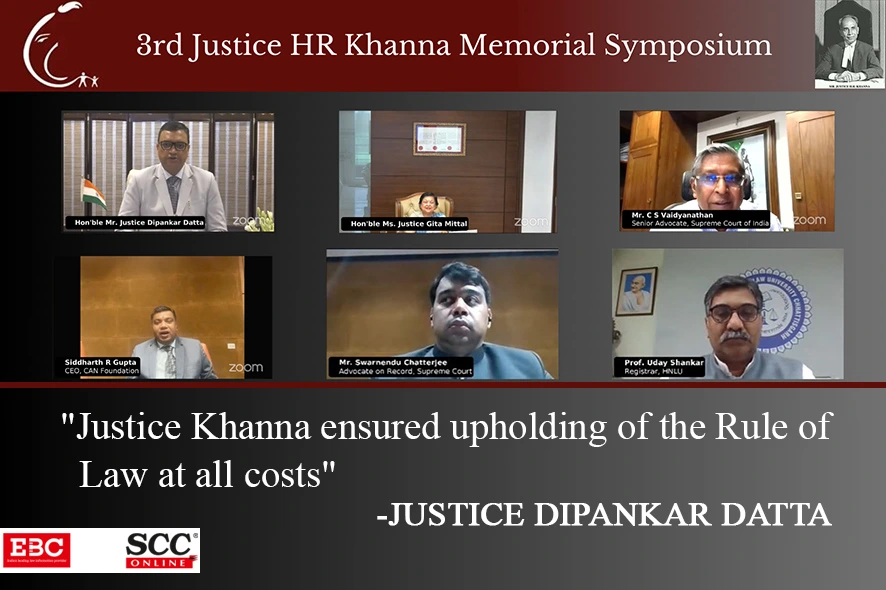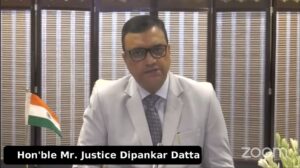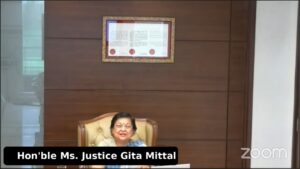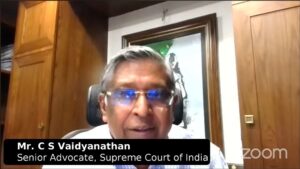“Men of character who have adorned our judicial institutions continue to dispense justice, fearlessly and with a sense of purpose, because these five distinguished jurists, alongside Justice Khanna and many more, played their role and shaped these institutions for generations to come.”–
Justice Dipankar Datta at ‘3rd Justice HR Khanna
Memorial National Symposium’
National Law Institute University, Bhopal and Hidayatullah National Law University, Raipur in collaboration with the CAN Foundation hosted the ‘3rd Justice HR Khanna Memorial National Symposium’ in remembrance of the illustrious persona of Late Justice H.R. Khanna, on 8th July 2023. There were two themes of the symposium with each theme being taken up in different sessions. The 2nd session was on “Legal Stalwarts and their contribution to the Modern Indian Judicial System”.
This Session of the Symposium was graced by Justice Dipankar Datta (Judge, Supreme Court of India), who was the Presiding Guest at the Symposium and saw the eminent presence of Justice Gita Mittal (Former Chief Justice J&K HC) and Mr. C.S. Vaidyanathan (Senior Advocate, Supreme Court) as the other panellists.
The session was moderated by a panel of young and upcoming lawyers of the nation, and comprised Ms. Archana Pathak Dave (AOR, SCI), Mr. Rajat Mittal (AOR, SCI), Mr. Swarnendu Chatterjee (AOR, SCI) and Mr. Sriram Parakkat (AOR, SCI).
Justice Dipankar Datta in his scintillating address demonstrated deep respect and admiration for the esteemed figures who have greatly influenced and left an everlasting impact on the Indian judicial system. Justice Datta highlighted the invaluable contributions of luminaries such as Justice Bijan Kumar Mukherjee (4th Chief Justice of India), Justice Y.V. Chandrachud (16th Chief Justice of India), Justice P.N. Bhagwati (17th Chief Justice of India), Mr. Nani A. Palkhivala (Sr. Advocate) and Justice D.D. Basu (Indian Jurist & Lawyer). Remembering these Legal Stalwarts, Justice Datta highlighted:
“They have Contributed to our judicial system in unique ways, and it is for them that our jurisprudence stands enriched and liberty for the common man remains guaranteed!”
While remembering these prominent Legal Stalwarts and their contributions, Justice Datta highlighted the importance of paying homage to Late Justice H.R. Khanna, who has left his mark on the Indian judiciary. Highlighting his contributions in the advancement of the Indian Constitutional Law, he said:
“Justice Khanna ensured upholding of the Rule of Law at all costs – no matter how dark the times or how uncertain the circumstances were. The far-sighted decisions rendered by Justice Khanna continue to have a huge impact on the evolution of Indian Constitutional Law, not only as precedents, but also guide all those constitutional functionaries who man the institutions of the ‘Modern Indian Republic’.”
Justice Datta then went on to express his immense gratitude towards Justice Khanna’s contribution to the Indian judiciary by highlighting his role in landmark judgements, such as the ADM Jabalpur case and the Kesavananda Bharati case. Emphasising on the importance of the Kesavananda Bharati case and its impact on the Doctrine of Basic Structure, Justice Datta remarked:
“There can possibly be no two opinions that the Constitutional Courts in India will continue to rely on the sacrosanct illumination that is provided by the ‘Basic Structure’ doctrine. Just as sunlight is said to be the best of disinfectants, the “Basic Structure” doctrine continues to be the sunlight epitomizing good governance and enhancing transparency and accountability in the governmental functions.”
After expressing his deepest regards, respect and reverence for Justice Khanna, Justice Datta then proceeded to the discussion surrounding the contributions of the other legal stalwarts. He began with Justice Bijan Kumar Mukherjea, the fourth Chief Justice of India by highlighting the exemplary judgements delivered by him, such as K.C. Gajapati Narayan Deo case, which thoroughly discussed the Doctrine of Colourable Legislation, the Rai Sahib Ram Jawaya Kapur, which discussed upon the Doctrine of Separation of Power, and the Shirur Math Case, where Justice Mukherjea propounded the Hindu Law of Religious Endowment. Justice Datta, while commending the remarkable judgments delivered by Justice Mukherjea, noted that:
“Among other opinions, all these judgements stand out as outstanding examples of judicial statements distinguished by profound erudition and clear explanation. The principles of law laid down by Justice Mukherjea have indeed stood the test of time and have well and truly enriched the system. The valuable contribution made by his Lordship to the judicial system can never be forgotten.”
Justice Datta then proceeded to discuss the contributions of Justice Y.V. Chandrachud, wherein he stated that Justice Chandrachud was admired throughout his tenure for his intellectual brilliance, scholarship, judicial vision and craftsmanship. He went to highlight his exemplary contributions through different landmark judgements which involved his distinguished opinions, such as the Gurbaksh Singh Sibbia case, which involved an interplay of the law of anticipatory bail in reference to the right to life under article 21 of the Constitution. Then he discussed the Minerva Mills case, which talked about the evolution of the Doctrine of the Basic Structure, which asserted immutability of fundamental constitutional features against amendments.
Justice Datta also recalled upon the landmark judgement of the Olga Tellis case delivered by Justice Chandrachud, and stated that:
“Article 21 was invoked to rule that Right to Life would include right to the means of livelihood which make it possible for a person to live and that the procedure for eviction of pavement and slum dwellers must, in the light of Article 21, be just, fair and reasonable. It is perhaps remarkable that a mere sentence from the judgement in Olga Tellis has so succinctly captured the entire jurisprudence on transformative constitutionalism”
Justice Datta also recounted for Justice Chandrachud’s large-heartedness through an anecdote. In the A.K.M Hassaanuzaman case, where challenge to the electoral rolls prepared by the State Election Commission was premised on the claim that legitimate voters were excluded and bogus voters were included, Justice Sabhyasachi Mukherjee, the then Judge of the Calcutta High Court was against the request of hearing the petition on one day and decide it by the next when the order was carried by the Supreme Court in appeal. In reference to the same, he passed the ad-interim order with utter dismay in form of strong observations, which were highlighted by Justice Datta:
“In my limited experience, as a Judge of this High Court for about 14 years, I have not known read or heard of such type of request, or direction or expression of hope by the Supreme Court, I do not know how far this, again, be it a request, direction or expression of hope, is consistent either with the dignity of the judicial process or comity amongst Courts and judicial functionaries.”
Justice Datta, while highlighting an example of Justice Chandrachud’s unwavering commitment to fairness, magnanimity as well as comity amongst Courts at all levels, made a remarkable observation in reference to the observation made by Justice Mukherjea, stating that:
“Such was the persona of Chief Justice Chandrachud that despite these strong observations made by Justice Mukharji and despite dismissal of the writ petition subsequently on 12th January, 1983 by a Constitutional Bench presided over by the Chief Justice in L.C. Sen, Justice Mukherjea was not only elevated to the Supreme Court two months later, on 15th March 1983 to be precise, during the regime of Chief Justice Chandrachud himself , but at a juncture which placed Justice Mukharji on the road to Chief Justiceship in 1989. I have my doubt, whether we will see a larger-hearted Chief Justice in future”
Justice Datta’s discussion shed light on the outstanding contributions of Justice Y.V. Chandrachud, showcasing his brilliance, visionary approach, and meticulous craftsmanship throughout his tenure. Reflecting on Chief Justice Chandrachud’s persona, Justice Datta expressed skepticism about witnessing a Chief Justice with such exceptional magnanimity in the future.
Justice Datta then moved on to address the great legacy left behind by Justice Bhagwati. He began by highlighting the remarkable concentrated efforts made by Justice Bhagwati in the field of Public Interest Litigation and Death Penalty. Justice Datta also went on to address his valuable contribution with respect to the criteria laid down for assessing the definition of State under article 12 of the Constitution, through the Ajay Hasla case. Justice Datta also recounted the judgement of Maneka Gandhi case, where the right to travel abroad was considered to be part of right to life under article 21, and the Francis Corelia Mullin case, where he observed that right to life includes the detenu’s right to confer with legal advisor and meet family and friends, and any unreasonable restriction would violate article 14 and 21. He also discussed the well-known Bandhua Mukti Morcha case, which dealt with the issue of bonded labour in India. He remarked that such outstanding judgements have paved the way for the current legal framework of our country.
Justice Datta said that if he wants to talk about the contributions of Justice Chandrachud, he can do no better than quote Justice Bhawgwati. While reminiscing about the opinions of Justice Bhagwati and Justice Chandrachud in various landmark judgements propounded by them, he recounted that:
“Both Chief Justices Chandrachud and Bhagwati authored trailblazing judgements on Constitutional Law and their exposition of legal principles serve as lighthouses guiding judges while they are in the dark and sailing on the choppy waters of the oceans.”
Justice Datta concluded his address by paying tribute to the enduring legacy of Justice Bhagwati. He emphasized the profound impact of Justice Bhagwati’s trailblazing judgments in Constitutional Law, serving as guiding lights for judges navigating through complex and challenging legal terrain.
Justice Datta also remembered Mr. Nani Palkhivala and stated that he was a person whose name evokes admiration and reverence. He is considered the embodiment of legal brilliance. While highlighting his contribution to the Indian Judiciary through P.V. Rao case, in the field of land acquisition and Kesavananda Bharati case, towards the Doctrine of Basic Structure, Justice Datta remarked:
“Palkhivala was not only a distinguished jurist who possessed a strong commitment to uphold constitutional liberties but was also an expert in economics, allowing him a command over the subject which enabled him to become one of the greatest tax lawyers our nation has ever produced.”
Commending his strong commitments towards the Judicial system and his role as a lawyer, Justice Datta observed:
“It must be said that central to Mr. Palkhivala’ success was his steadfast commitment to his beliefs and his unwavering intellectual integrity”
Justice Datta fondly remembered the esteemed Mr. Nani Palkhivala, a name that commands admiration and respect. Widely regarded as the epitome of legal excellence, Mr. Palkhivala made profound contributions to the Indian Judiciary.
Lastly, Justice Datta proceeded on to highlight the significant contributions made in the field of Constitutional Law by Dr. Durga Das Basu in juristic and academic fields. While recalling the view of different legal stalwarts regarding Dr. Basu, Justice Datta stated that:
“For the less discerning and uninitiated, Dr. Basu is perhaps the only great academic and jurist who adorned the high Constitutional office of a judge of a High Court. I take enormous pride in saying that I started my career as a judge of the High Court of which Dr. Baus was a judge during 1963 to 1971 ”
Justice Datta highlighted that the first edition of Dr. Basu’s commentary on the Constitution was published in November 1950 when hardly any decision of the Supreme Court had been rendered to assist him in preparation of his comments. Emphasising on the unique and experimental character of his commentary, Justice Datta observed:
“Dr. Basu’s commentary on the Constitution of India is regarded as an immortal creation of a rare genius. ”
Justice Datta concluded his address by shining a spotlight on the remarkable contributions made by Dr. Durga Das Basu in the field of Constitutional Law, both as an Academic and a Jurist. Acknowledging the perspective of various legal luminaries, Justice Datta emphasized that Dr. Basu stands out as a unique figure, being one of the few who seamlessly transitioned from an illustrious academic career to hold the esteemed position of a High Court judge.
Justice Datta then moved on to conclude his speech for the day, emphasising on the contributions made by all the legal stalwarts and the judgements rendered by them which have played an important role in safeguarding the Basic Structure of the Constitution from time to time, while never losing sight of the core importance of the Fundamental Rights granted under part III of the Constitution. While cherishing these contributions, he remarked:
“Men of character who have adorned our judicial institutions continue to dispense justice, fearlessly and with a sense of purpose, because these five distinguished jurists, alongside Justice Khanna and many more, played their role and shaped these institutions for generations to come.”
Address by Hon’ble Justice Gita Mittal-
Following this, Gita Mittal paid tribute to women lawyers and judges who helped shape the Indian legal field and contributed to the role of empowerment of women in law. She focused on their contributions to jurisprudence as well as on how they have worked towards the growth and progress of women within the Indian judicial system. She highlighted the invaluable contributions of luminaries such as Cornelia Sorabji (Indian lawyer), Regina Guha (Indian lawyer ), Justice Anna Chandy (Former Judge, High Court of Kerela), Indira Jay Singh (Indian lawyer), Justice J.S. Verma (27th Chief Justice of India) and Justice Brenda Hale (Former President of the Supreme Court, United Kingdom). Justice Mittal emphasized the issue of gender diversity in the Indian Judiciary by pointing out the minimal number of women in the Supreme Court and High Courts.
Justice Gita Mittal began her speech by acknowledging the tremendous challenges that women face in breaking through the numerous barriers that exist. She recognised that women have to work incredibly hard to overcome these obstacles and reach considerable positions and that this can be a long and arduous journey. She discussed the historical dominance of men in the legal profession, with women initially being excluded from studying and practising law:
“The profession has been male-dominated, women are forced to find creative ways to break in among the privileged few. It is important to their contributions to both the bar and bench. Lack of gender diversity in the bench continues to be the norm.”
Justice Mittal started her speech by discussing Ms.Corneli Sorabji and Ms.Regina Guha. Justice Mittal first mentioned Ms. Sorabji, who was the first woman to graduate from Bombay University and despite having studied law at Oxford, was denied the right to practice as a lawyer at Court.
She then proceeded to discuss Ms. Regina Guha, another pioneer, who applied for being enrolled as a pleader at the Court of the District Judge of Alipur after completing her studies but faced discrimination due to the prevailing disparity in gender equality, due to which her application was rejected. However, her struggle became the foundation for Dr. Hari Singh Gour to introduce a bill in 1924 to end gender discrimination. The proposed bill contained an amendment that had to be fixed to the applicable Advocates Act, the then version of which did not provide legal recognition to women as Advocates. Highlighting the incident, she remarked:
“A 5- Judge Bench of the Calcutta High Court unanimously held that only males can be pleaders and she (Guha) changed her profession. But her application later led to amendment.”
She emphasised that these incidents were not isolated but a part of a more significant movement. To elaborate on this, she cited the examples of Indira Jaising and Meenakshi Arora, who have also made significant contributions to promoting women’s rights and access to justice.
Justice Mittal emphasised the importance of gender diversity in the legal field, leading to inclusive decision-making and breaking down stereotypes and biases. A balanced judiciary that reflects the demographics of society is crucial for maintaining the credibility and legitimacy of legal institutions:
“Indian legal fraternity, what it is today and it depicts the need for gender diversity and equality. Gender diversity in the legal fields leads to inclusive decision-making. It ensures that a broader range of perspectives and experiences are considered when interpreting and applying the law.”
She shared anecdotes and experiences from other countries, highlighting the contributions of women judges globally. She gave a particular example of Justice Ruth Bader Ginsburg, the Judge of the Supreme Court of the U.S., who always advocated for the appointment of more women to the bench of the Supreme Court of the United States. She also mentioned the Chief Justice of the United Kingdom, Lady Brenda Hale and Justice Navanethem Pillay, a Judge of the High Court of South Africa.
She proposed various changes to address these challenges, such as enhancing access to legal education, creating work-life balance initiatives, implementing flexible work arrangements, establishing mentorship programs, ensuring objective criteria for evaluating women’s work, and promoting gender-sensitive policies. She called for a collective effort to create an environment that enables all individuals, regardless of gender, to excel in pursuing justice. By doing so, India can establish a legal system that truly reflects the values and aspirations of the nation.
Address by Sr. Advocate C.S. Vaidyanathan-
Following Justice Gita Mittal’s engaging session, Mr. C.S. Vaidyanathan paid homage to three legal luminaries, namely Mr. Nambiar, Justice Krishna Iyer, and Justice H.R. Khanna, who played instrumental roles in shaping the Indian judicial system. Mr. Vaidyanathan emphasised the significance of their contributions to advancing constitutional jurisprudence during a time when the field was still nascent.
Mr. Vaidyanathan began his speech by highlighting the intellectual brilliance and erudite jurisprudential grounding of lawyers in pre-independence India. He commended their missionary outlook and the way they navigated the ship of the judiciary through turbulent times, where the legislature and executive often overshadowed individual human rights. These lawyers championed the humanism of the individual against the mighty state.While emphasising the importance of just and fair treatment and upholding individual liberties under the rule of law, Mr. Vaidyanathan stated:
“Through the sheer intellectual brilliance and erudite jurisprudential grounding and missionary outlook, they chartered the ship of judiciary.”
Mr. Vaidyanathan credited Mr. Nambiar as an eminent Jurist who made an extensive study of the Constitutions of the world and had a strong grounding in Constitutional and Administrative law extensively. His in-depth knowledge of the Constitutions of various countries, particularly the United States, allowed him to argue in A.K. Gopalan v. State of Madras in the Supreme Court of India. Despite the Court not fully agreeing with him, Mr. Nambiar’s arguments strengthened and nurtured the development of the ‘Basic Structure Doctrine’ and the recognition that all authorities, including the legislature, should be subject to the Constitution and the rule of law.
Mr. Vaidyanathan praised Justice Krishna Iyer’s deep commitment to individual liberty and justice. He described Justice Krishna Iyer as a fierce advocate for ‘Bail as the Rule and Jail as the Exception’, emphasising the importance of protecting individual freedoms. Further acknowledgeding that he had personal experience working with Justice Krishna Iyer, who guided him in identifying critical arguments and taught him the importance of analysing judgments comprehensively, he highlighted:
“While enacting a law there will be some persons who will be martyrs. We can’t have that kind of persons whose rights are trampled upon in regard to individual liberties personal Liberty freedom. You have to trust the law as being just fair and reasonable in respect of each and every individual”
Mr. Vaidyanathan highlighted Justice H.R. Khanna’s unwavering belief in the supremacy of the Constitution and the ‘Rule of Law’. He mentioned Justice Khanna’s courageous decision in A.D.M. Jabalpur & Ors v. Shivkant Shukla to stay the execution of the Emergency-era order that allowed for preventive detention. Mr. Vaidyanathan also spoke of Justice Khanna’s commitment to personal liberties, his emphasis on the principle of ‘Bail not Jail’, and his efforts to protect the rights of prisoners and undertrials.
Mr. Vaidyanathan after extensively discussing the three luminaries, commented on the contemporary regimen of law in India. He lamented the current state of affairs, where issues such as custodial interrogations and denial of bail seem to have lost sight of the core principles these legal luminaries advocated. While emphasising the need to revive their deep thinking and remind ourselves that the Constitution and the rule of law are supreme, Mr. Vaidyanathan remarked:
“We need to revive the spirit with which these individuals advanced the thinking that it is the rule of law which has to prevail in a democracy.”
He urged the legal community to revive their spirit and uphold the principles these legal luminaries championed. Mr. C.S. Vaidyanathan, in the end, urged the legal community to revive their spirit and uphold the principles of these legal luminaries. By doing so, he concluded that India can maintain a democratic system rooted in justice, fairness, and the supremacy of the Constitution.
The Entire Session can be viewed at: https://www.youtube.com/watch?v=dl6M_v86fXs
SCC-EBC group were the Knowledge Partners of the event with Bar and Bench as the Media Partner.
—–










